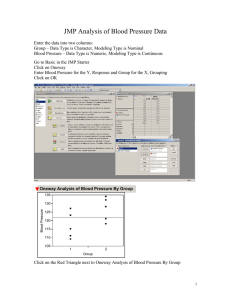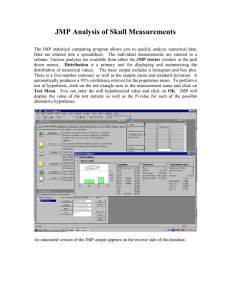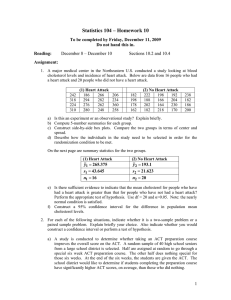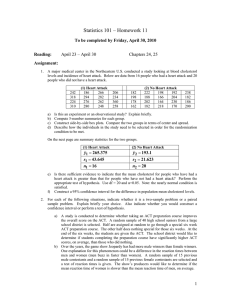Stat 301 -- Fall 2015 -- Midterm exam... Information and JMP output
advertisement
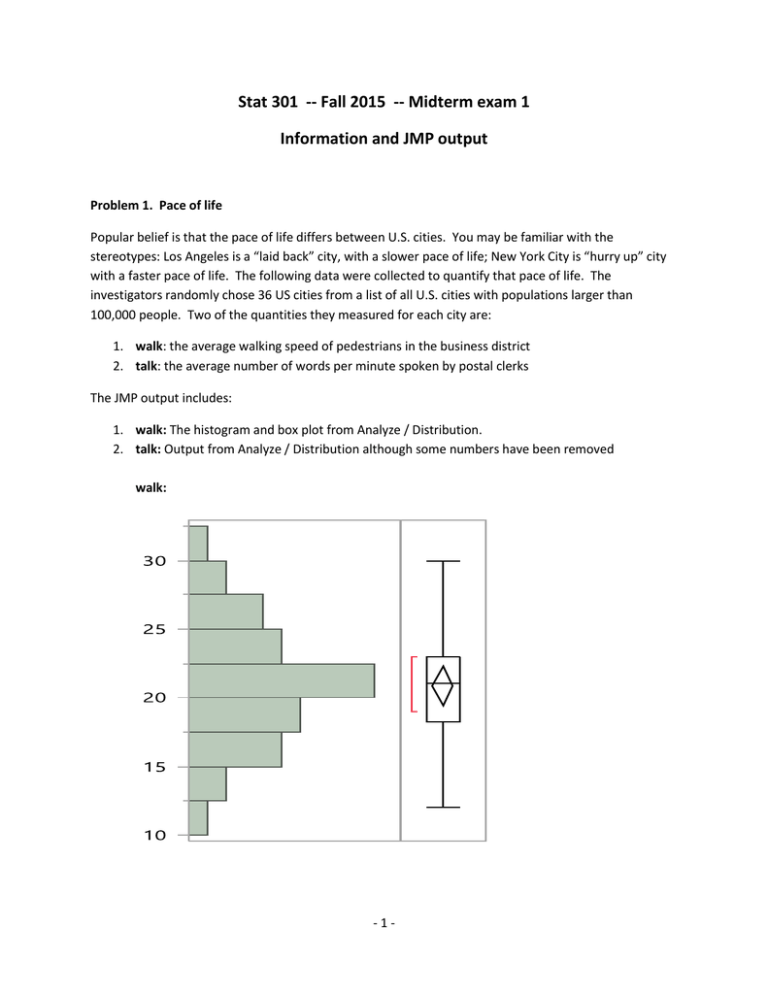
Stat 301 -- Fall 2015 -- Midterm exam 1 Information and JMP output Problem 1. Pace of life Popular belief is that the pace of life differs between U.S. cities. You may be familiar with the stereotypes: Los Angeles is a “laid back” city, with a slower pace of life; New York City is “hurry up” city with a faster pace of life. The following data were collected to quantify that pace of life. The investigators randomly chose 36 US cities from a list of all U.S. cities with populations larger than 100,000 people. Two of the quantities they measured for each city are: 1. walk: the average walking speed of pedestrians in the business district 2. talk: the average number of words per minute spoken by postal clerks The JMP output includes: 1. walk: The histogram and box plot from Analyze / Distribution. 2. talk: Output from Analyze / Distribution although some numbers have been removed walk: -1- talk: Quantiles 100.0% 90.0% 75.0% 50.0% 25.0% 10.0% 0.0% maximum minimum 27 24.3 23.75 22 18 14.7 10 Summary Statistics Mean Std Dev Std Err Mean Upper 95% Mean Lower 95% Mean N 20.583333 3.8572751 0.6428792 21.888447 19.278219 36 -2- Test Mean Hypothesized Value Actual Estimate DF Std Dev 20 20.5833 35 3.85728 t Test Test Statistic Prob > |t| Prob > t Prob < t 0.3704 0.1852 0.8148 Test Mean Hypothesized Value Actual Estimate DF Std Dev 22 20.5833 35 3.85728 t Test Test Statistic Prob > |t| Prob > t Prob < t 0.0342* 0.9829 0.0171* Test Mean Hypothesized Value Actual Estimate DF Std Dev 24 20.5833 35 3.85728 t Test Test Statistic Prob > |t| Prob > t Prob < t <.0001* 1.0000 <.0001* -3- Problem 2: Music and attention span These data are part of a study of whether music is a potential distraction. Subjects were asked to pay attention to a sequence of simple tasks. An eye tracking device was used to determine when their attention wandered. The response is the time in minutes when the subject’s attention wandered. This measurement was made when a subject was listening to rap music through headphones (the Music group) or to silence while wearing the headphones (the Control group). Subjects were randomly assigned to group (Music or Control). There are 22 subjects are in the Music group and 28 are in the Control group, for a total of 50 subjects. The JMP output includes, in order: results from a two-sample t-test assuming equal variances (Fit Y by X / Fit Line / ANOVA Pooled T) information about the means and standard deviations for each group (Fit Y by X / Fit Line / Means) results from a two-sample t-test assuming unequal variances (Fit Y by X / Fit Line / T-test) Certain numbers have been deleted. Oneway Analysis of AttTime By Group Oneway Anova Summary of Fit Rsquare Adj Rsquare Mean of Response Observations (or Sum Wgts) 0.179816 0.162729 4.1696 50 -4- t Test Music-Control Assuming equal variances Difference Std Err Dif Upper CL Dif Lower CL Dif Confidence -2.2688 0.6994 -0.8626 -3.6750 0.95 t Ratio -3.24399 Prob > |t| Prob > t Prob < t 0.0021* 0.9989 0.0011* Analysis of Variance Source Group Error C. Total DF Sum of Squares 1 63.41474 48 289.24945 49 352.66419 Mean Square 63.4147 6.0260 F Ratio 10.5235 Prob > F 0.0021* Means for Oneway Anova Level Control Music Number 28 22 Mean 5.16786 2.89909 Std Error 0.46391 0.52336 Lower 95% 4.2351 1.8468 Upper 95% 6.1006 3.9514 Std Error uses a pooled estimate of error variance Means and Std Deviations Level Control Music Number Mean Std Dev 28 22 5.16786 2.89909 2.60065 2.25344 Std Err Mean 0.49148 0.48044 t Test Music-Control Assuming unequal variances Difference Std Err Dif Upper CL Dif Lower CL Dif Confidence -2.2688 0.6873 -0.8865 -3.6510 0.95 t Ratio DF Prob > |t| Prob > t Prob < t -3.30103 47.49524 0.0018* 0.9991 0.0009* -5- Lower 95% Upper 95% 4.1594 1.9000 6.1763 3.8982 Problem 3: diversity of butterfly species in remnant patches of tropical rain forest The data for this question come from one of the first experimental studies of the consequences of forest fragmentation. A logger agreed to leave patches of forest uncut inside a large area that was to be logged. The experimenters identified 16 locations were a patch would be uncut. The treatment was the size of the uncut patch, which was randomly assigned to locations. The patches ranged in size from 1 hectare (ha) to 1000 ha. Two years after logging, each patch was surveyed for butterflies. The response variable is the number of different butterfly species found on the patch. Theory suggests that diversity is linearly related to the log of the patch area. The variable log Area is the area in log base 10 (so a 1 ha patch is LogArea = 0, a 10 ha patch is LogArea=1, a 100ha patch is LogArea = 2 and a 1000ha patch is LogArea = 3). The JMP output is all computed with Analyze / Fit Y by X / Fit Line. That output includes a plot of the data with the fitted regression line information about the fit of the line parameter estimates The output is followed by a copy of the data table with: predicted values, the columns created by Mean Confidence Interval Formula and the columns created by Individ Confidence Interval Formula. Information for “new” observations with areas of 25 ha and 250 ha is included after the observations. Bivariate Fit of species By log Area Linear Fit species = 36.25 + 28.5*log Area -6- Summary of Fit RSquare RSquare Adj Root Mean Square Error Mean of Response Observations (or Sum Wgts) 0.589594 0.560279 23.77799 64.75 16 Analysis of Variance Source Model Error C. Total DF Sum of Squares 1 11371.500 14 7915.500 15 19287.000 Mean Square 11371.5 565.4 F Ratio 20.1126 Prob > F 0.0005* Parameter Estimates Term Intercept log Area Estimate 36.25 28.5 Std Error 8.701854 6.354935 t Ratio 4.17 4.48 Prob>|t| 0.0010* 0.0005* Lower 95% 17.58638 14.870019 Data Table with predicted values and intervals area species log Area Predicted # species 1 14 0 36.25 1 50 0 36.25 1 55 0 36.25 1 34 0 36.25 1 40 0 36.25 1 57 0 36.25 10 43 1 64.75 10 103 1 64.75 10 33 1 64.75 10 53 1 64.75 10 50 1 64.75 100 110 2 93.25 100 70 2 93.25 100 119 2 93.25 100 60 2 93.25 1000 145 3 121.75 25 . 1.39 76.09 250 . 2.39 104.59 StdErr Pred. species 8.70 8.70 8.70 8.70 8.70 8.70 5.94 5.94 5.94 5.94 5.94 8.70 8.70 8.70 8.70 14.03 6.46 10.68 -7- 95% for the line Lower Upper 17.58 54.91 17.58 54.91 17.58 54.91 17.58 54.91 17.58 54.91 17.58 54.91 52.00 77.49 52.00 77.49 52.00 77.49 52.00 77.49 52.00 77.49 74.58 111.91 74.58 111.91 74.58 111.91 74.58 111.91 91.65 151.84 62.23 89.94 81.66 127.51 95% Individ obs Lower Upper -18.05 90.55 -18.05 90.55 -18.05 90.55 -18.05 90.55 -18.05 90.55 -18.05 90.55 12.18 117.31 12.18 117.31 12.18 117.31 12.18 117.31 12.18 117.31 38.94 147.55 38.94 147.55 38.94 147.55 38.94 147.55 62.53 180.96 23.24 128.93 48.67 160.50 Upper 95% 54.91362 42.129981

